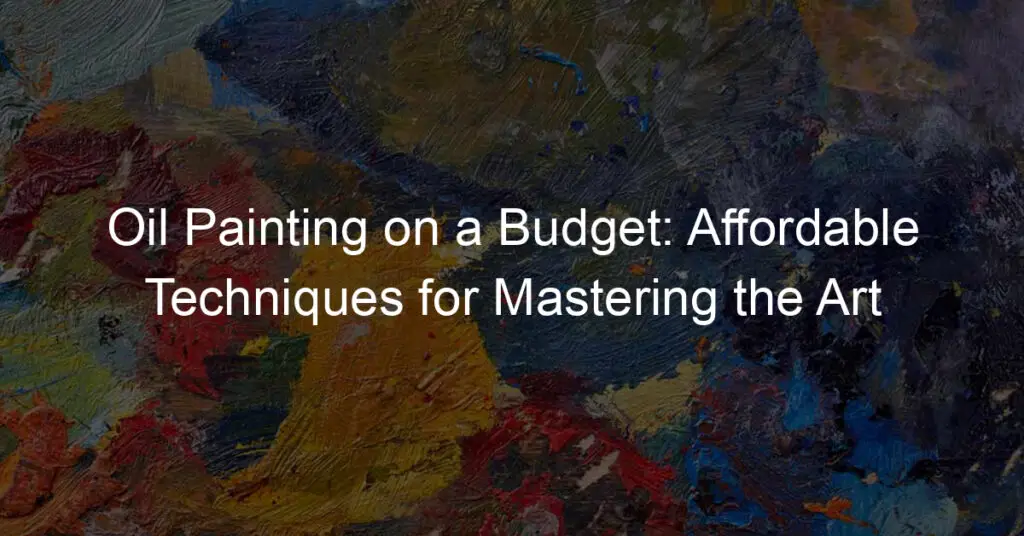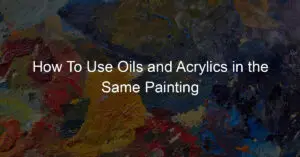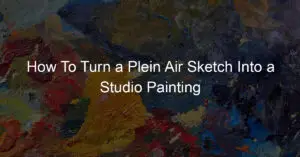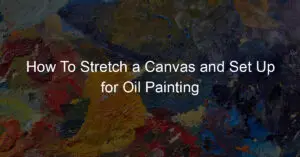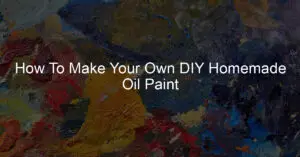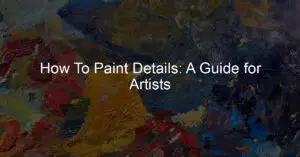Oil painting can be an incredibly rewarding and therapeutic pastime, allowing artists to express their creativity and emotions on canvas.
However, many aspiring painters are intimidated by the perceived costs associated with this medium.
Fortunately, oil painting on a budget is not only possible but can also yield magnificent results without breaking the bank.
It’s important to know that there are a variety of high-quality, yet affordable, oil paints, brushes, and canvases available on the market today.
With a few simple tips and tricks, anyone can create beautiful oil paintings that rival more costly alternatives.
Learning to prioritize certain supplies, finding alternative resources, and practicing patience in your craft can ensure your passion for oil painting doesn’t drain your wallet.
In this article, we’ll explore cost-effective ways to dive into the world of oil painting, including recommendations for budget-friendly materials, techniques for maximizing your supplies, and essential skills to elevate your artwork without spending a fortune.
Choosing the Right Materials
Budget-Friendly Paint Brands
When starting with oil painting, it’s essential to select paint brands that offer both affordability and quality. Several budget-friendly options are available, such as:
- Winton by Winsor & Newton: This brand offers good-quality oil paint at a lower price, perfect for beginners.
- Daler-Rowney Georgian: Known for its reliability and range of colors, Daler-Rowney Georgian allows you to experiment without breaking the bank.
- Gamblin: Gamblin offers a student-grade line called 1980 Oil Colors which provides great quality for a lower cost.
Inexpensive Canvas Options
In terms of canvas, you have a few affordable options to choose from:
- Artist Canvas Panels: Pre-primed and ready to use, these panels are ideal for beginners. They offer a smooth surface and can be easily found in most art supply stores.
- Stretch Your Own Canvas: While it may require some extra effort, stretching your own canvas can save you money in the long run. You only need to purchase raw canvas and stretcher bars and follow a tutorial for the setup process.
- Canvas Pads: This option provides multiple sheets of primed canvas, which are perfect for practicing and experimenting with oil painting techniques. Their portability also makes them suitable for plein air painting.
Affordable Brushes and Tools
Selecting an appropriate set of brushes and tools is crucial for successful oil painting. Here, you’ll find cost-effective options that don’t compromise on quality:
- Brush Sets: Look for synthetic or natural bristle brush sets. Sets often cater to beginners and come at a discounted price compared to purchasing individual brushes.
- Palette Knives: Inexpensive plastic or metal palette knives are widely available and suitable for mixing paint. Their variety of shapes allows for different effects in your artwork.
- Painting Surfaces: Masonite boards or even repurposed wooden surfaces can be used as cost-effective alternatives to traditional canvases. Ensure they are properly primed before use to improve paint adhesion and prevent damage.
Considering these budget-friendly options for paint brands, canvas, and brushes can save costs while maintaining the quality of your oil painting materials.
This approach allows you to experiment and develop your skills in oil painting without excessive financial pressure.
Creating a Limited Palette
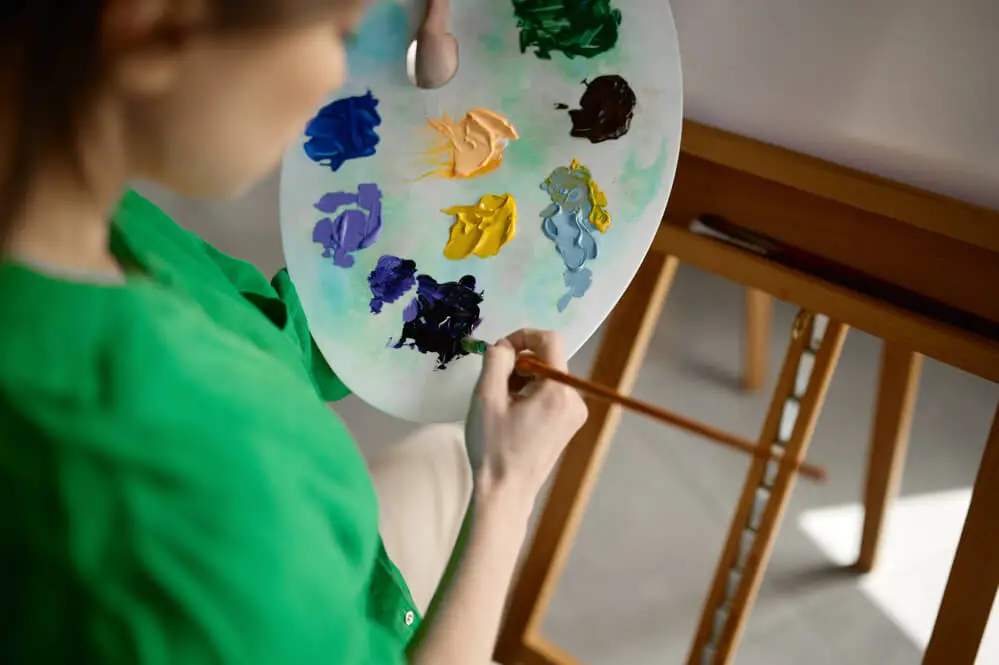
When working with oil paints, it can be cost-effective to create a limited palette of colors. This not only helps you stay on budget, but it also encourages you to learn color mixing techniques.
A limited palette typically includes eight essential pigments plus white. These are titanium white, yellow, cadmium yellow, cadmium red, ultramarine blue, phthalo green, and burnt umber.
Titanium White is an essential pigment. It’s used for lightening and adjusting colors and is the most commonly used white paint.
To have a versatile range of colors, consider these three primary colors, which can be mixed to create a vast array of hues:
- Cadmium Yellow: A warm yellow, perfect for bright, sunny shades or mixing with red for warm oranges.
- Cadmium Red: A rich, warm red that can be mixed with yellow or blue to create oranges and purples, respectively.
- Ultramarine Blue: A cool blue that mixes well with red for purples or with green for cooler shades.
In addition to the primaries, there are indispensable secondary colors to aid in mixing and for specific shades:
- Yellow: This could be a cool yellow, such as lemon yellow, that will help create cooler greens and oranges.
- Phthalo Green: A cool green that creates brilliant, vibrant hues and mixes with blue for deep, dramatic ocean colors.
- Burnt Umber: A versatile dark brown, perfect for mixing earthy colors or toning down other pigments.
When selecting your limited palette, keep in mind the following:
- Choose quality over quantity. Invest in a few good-quality paints rather than many low-quality ones. This will lead to better color mixing and longevity of your paintings.
- Stick to well-known brands, as their pigments will have more uniform quality and consistency.
- Experiment with different combinations of colors. Learn which pigments work best together and which ones tend to muddy or create less-than-ideal hues.
- Finally, remember that practice makes perfect. The more you work with your limited palette, the better you will become at using it to create a wide range of colors and effects.
Color Theory and Mixing
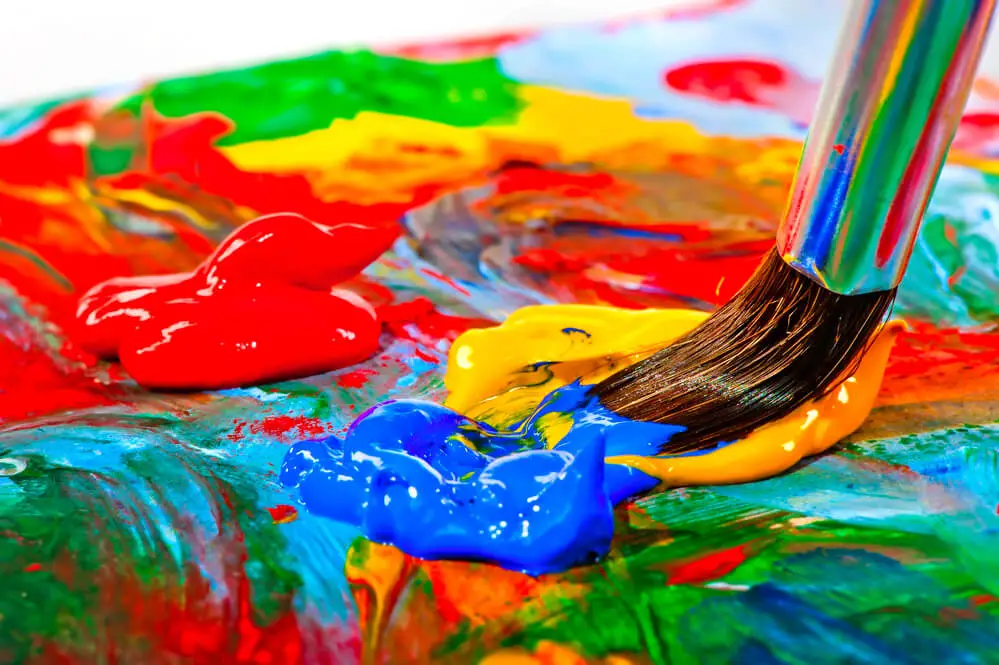
Color theory is an essential aspect of oil painting, as it helps artists understand how colors interact and complement each other. The color wheel, which consists of primary, secondary, and tertiary colors, is the foundation of color theory.
The primary colors are red, blue, and yellow. Secondary colors—green, orange, and purple—are created by mixing primary colors. Tertiary colors, such as blue-green, result from mixing primary and secondary colors.
Understanding pigments is crucial when working with oil paints. Pigments are finely ground-colored particles suspended in a binding medium, such as linseed oil.
When selecting paint, consider the pigment quality, as cheaper paints often contain less pigmentation, leading to weaker colors or less coverage.
Mixing colors is a vital skill for creating the desired tone, shade, or tint in your oil painting. Start by using a palette knife or a brush to mix two colors in small amounts on your palette. Gradually add more of each color to achieve the desired hue. Mixing colors can be achieved by blending complementary colors or varying the ratios of your primary colors.
The consistency of your paint also plays a significant role in mixing colors. Adding solvents or oils such as turpentine or linseed oil can alter the consistency, making the paint thinner or thicker.
Thinner paint can be used for lighter layers or washes, while thicker paint is suitable for impasto techniques or adding texture.
Experiment with these additives to find the right balance of consistency and drying time. Remember that a higher consistency will impact the painting’s overall appearance.
Oil painting allows for a vast range of colors and shades, but it is essential to work with a limited color palette when starting.
A limited palette consisting of primary colors and a few secondary colors can help you achieve most color variations.
Moreover, working with fewer colors provides a sense of unity throughout the artwork, making it easier to balance and harmonize your composition.
Preparing the Painting Surface
When starting an oil painting on a budget, selecting and preparing the right surface can make all the difference. There are various options available in terms of materials, such as canvas, wood panels, and paper.
Canvas is a popular choice for oil painting and comes in two types: cotton and linen. Cotton canvas is the more budget-friendly option, whereas linen is a bit more expensive.
You can purchase pre-stretched and primed canvases, saving you time and effort, or stretch and prime the canvas yourself to save money.
To prime a canvas, apply a few layers of gesso, which is an affordable white primer that creates a good surface for oil paints. Gesso also prevents the paint from soaking into the fibers of the canvas.
Apply the gesso with a brush in a thin, even layer, and sand it lightly between each layer to create a smooth surface with the desired texture.
Wood panels, as an option for painting surfaces, are sturdy and can be more budget-friendly. They also come in a variety of textures, sizes, and types of wood.
To prepare a wood panel for oil painting, apply a layer of gesso or another primer to prevent the paint from reacting with the wood.
If you’re using wood that might be prone to warping, sealing the panel with an acrylic sealer before applying gesso can help ensure its durability.
Paper is the least expensive option for an oil painting surface, and there are oil painting papers available specifically treated for this purpose.
Yet, it’s essential to prime paper with gesso before applying oil paint to prevent the paint from soaking in and causing the paper to deteriorate.
In conclusion, whether you choose canvas, wood panels, or paper as your painting surface, proper preparation is essential for achieving the best results.
Priming your chosen surface with gesso or a suitable alternative will help ensure the longevity of your oil painting while sticking to a budget.
Developing Techniques on a Budget
When it comes to oil painting, there is no need to break the bank to develop your techniques. With a few simple tips, you can gain knowledge and become confident in your skills while staying on budget.
Firstly, learning is an essential aspect of developing your oil painting techniques. Visit your local library, browse the internet, or watch online tutorials from experienced artists.
Exposing yourself to different styles and methods can gather a wealth of knowledge without spending a dime.
Experimenting with various techniques is another way to grow as an artist while keeping costs low. One affordable tool you can use is the palette knife.
A palette knife can be a cost-effective alternative to brushes and provides a unique texture to your artwork. Experiment with applying paint using different angles and pressures to create interesting effects.
When it comes to materials, you don’t need to splurge on pricey paints to improve your oil painting techniques.
Practice with student-grade paints; they are more budget-friendly than professional-grade options and still offer good color quality. As you become more confident in your skills, you can gradually invest in higher-quality materials.
Finally, consider forming a group with fellow amateur oil painters to share knowledge, techniques, and possibly even materials.
This not only provides a supportive network for you to learn and experiment but also allows further cost-saving opportunities through bulk purchasing of supplies.
Focusing on learning, experimenting with techniques such as the palette knife, and making smart choices with materials, it is possible to develop your oil painting skills without breaking the bank.
Budget-Friendly Studio Setup
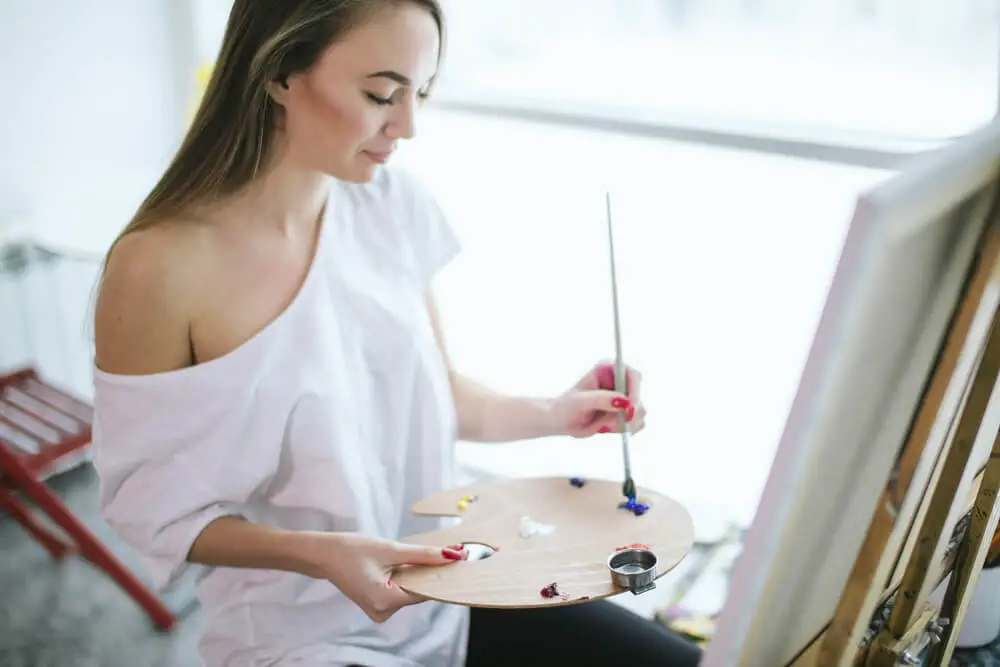
Setting up an affordable oil painting studio is not as daunting as it may sound. With a few smart choices and cost-saving tips, you can create a functional space without breaking the bank.
First and foremost, an easel is essential for your studio. While there are many options on the market, a simple wooden A-frame easel should be more than sufficient for a beginner.
These can be found at affordable prices at art supply stores or online. If you are short on space, consider a tabletop easel, which can be easily stored away when not in use.
When it comes to backgrounds, utilize what you already have available. If you have a blank wall in your home, that can easily serve as a backdrop for your paintings.
Alternatively, invest in a few sheets of large, unprimed canvas. These can be hung on the wall or draped over your easel to provide a neutral background that won’t compete with your art.
A well-planned space is crucial for a budget-friendly studio. Try to dedicate a specific area for your oil painting endeavors. This will not only help keep your supplies organized but will also prevent any accidental damage to your living space.
If possible, choose an area with natural light or supplement with affordable clamp-on lamps, which can be easily attached to shelves or tables for focused illumination.
To ensure clean edges on your paintings, masking tape is a cost-effective solution. Simply apply it to the edges of your canvas or painting surface, and remove it once your artwork is dry.
This will give your paintings a sharp, professional appearance without the need for expensive framing.
A budget-friendly studio setup for oil painting can be achieved by prioritizing essential items like an easel, leveraging existing backgrounds and walls, organizing your space, and using affordable materials to maintain clean edges.
With these tips in mind, you can create a functional and efficient workspace without overspending.
Making the Most of Inexpensive Materials
When you want to create a beautiful oil painting but are on a tight budget, it’s essential to find economical ways to acquire materials without sacrificing quality.
From fine art to contemporary art, it’s possible to create stunning works even as a novice if you know where to look and how to best utilize the materials available to you.
Selecting affordable fabrics for your canvas is the first step. Cotton duck or cotton-polyester blends provide cost-effective options without compromising the quality of the artwork.
These durable materials are suitable for both fine art paintings and contemporary art styles. Additionally, look for suppliers that offer discounts for bulk purchases to save money over time.
Choosing the right paintbrushes is fundamental to creating impressive artwork. While high-quality brushes are often expensive, it’s not necessary to overspend on this essential tool.
Inexpensive yet effective alternatives include synthetic bristles or hog hair brushes for a more affordable option.
You can also take advantage of sales or clearance items to add quality brushes to your collection without exceeding your budget.
Though renowned brands such as Sennelier produce exquisite oil paints, these may not always be feasible for artists working on a small budget.
Search for reputable manufacturers that offer low-cost oil paints with good pigment load and consistency.
Mont Marte or Winsor & Newton Winton are examples of well-regarded brands that provide quality at an economical price point.
Oil painters can also save money by repurposing household items for sculptural effects. For instance, instead of purchasing expensive impasto mediums, you could substitute household items like sawdust or sand to give your artwork a textured appearance.
This technique is ideal for artists looking to experiment with three-dimensional applications in their paintings.
In conclusion, exploring inexpensive materials and using creative techniques can help you achieve stunning oil paintings on a limited budget. Maintain quality by choosing cost-effective alternatives in fabrics, paint brushes, and oil paints.
Further, repurpose household items for sculptural effects to enhance your artwork affordably. Following these tips can produce exceptional artwork while remaining financially conscious.
Considerations for Pricing and Selling
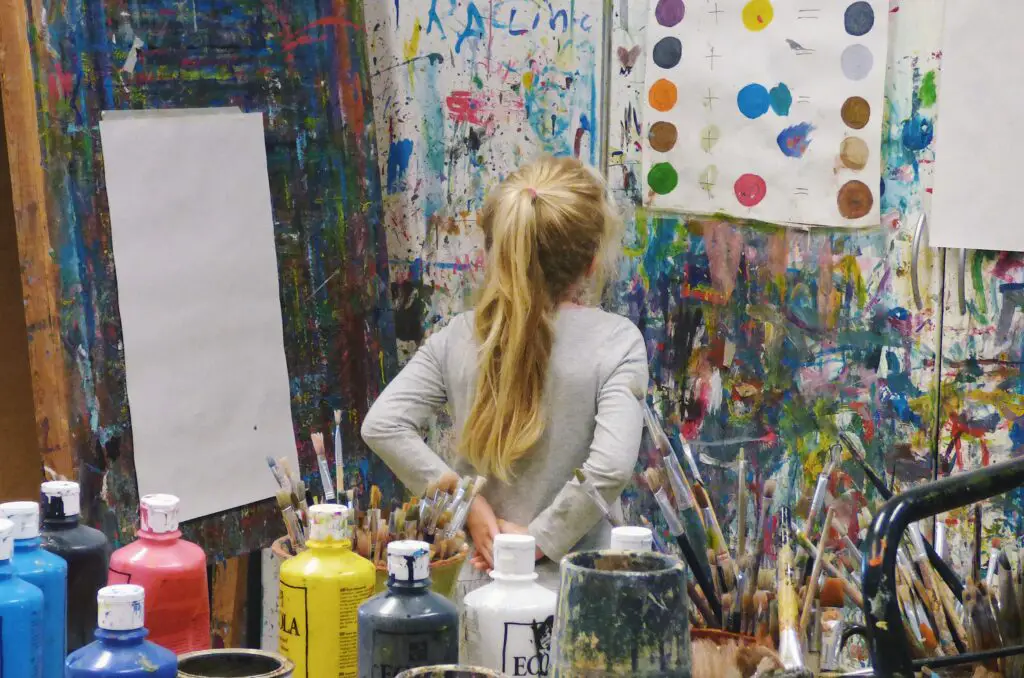
When it comes to oil painting on a budget, it is essential that you are confident, knowledgeable, and have a clear understanding of pricing and selling considerations.
In this section, we will discuss significant factors to keep in mind as you price and eventually sell your artwork.
First, you should consider your costs, which include the materials used in creating the painting (canvas, oil paints, and brushes), as well as any overheads you might have (e.g., studio rent, utilities, and marketing expenses).
Keep track of these costs so you can accurately price your paintings and ensure you are making a profit.
When setting your prices, it’s vital to research the market. Analyze similar oil paintings in terms of style, size, and the artist’s reputation, which are currently on sale or have been sold recently.
This information will help you gauge where your artwork fits in the market and find a suitable price range.
Next, consider the pricing strategies available to you. Some artists prefer a cost-based pricing method, where they calculate their costs and add a pre-determined profit margin.
Others use a value-based approach, where the artwork’s price is determined by its perceived value in the eyes of collectors and potential buyers.
Whichever approach you choose, be consistent in your pricing – inconsistent prices can confuse buyers and reduce their willingness to purchase.
Involving yourself with galleries can often assist you in selling your artwork, especially if you don’t have a large following or a substantial reputation in the art world.
Galleries specialize in promoting and selling art and have the resources and connections to help you reach potential buyers.
Keep in mind, though, that galleries typically take a commission (usually around 50%) from the sale of your artwork, so be sure to factor this into your pricing.
Creating a strong online presence can also aid in selling your oil paintings. You may choose to sell your artwork through online platforms, social media, or a personal website.
Ensure that your online presence reflects your style and professionalism and clearly displays your artwork, along with pricing and purchasing information.
Lastly, don’t forget the importance of networking as an artist. Attend art fairs, exhibitions, workshops, and other events where you can engage with fellow artists, collectors, and art enthusiasts.
Building relationships within the art community can lead to increased exposure and collaborations and, ultimately, facilitate the selling of your artwork.
Conclusion
Oil painting can be an enjoyable and fulfilling hobby, even for those on a budget.
Choosing affordable materials, opting for budget-friendly alternatives, and taking care of your supplies can create beautiful art without breaking the bank.
Remember, student-grade paints are a great option for those looking to save money while still achieving good results.
Mixing just a few basic colors can help you explore a wide range of shades, allowing you to grow as an artist without purchasing an extensive palette.
Don’t underestimate the power of using household items as tools.
For example, using a palette knife made from a discarded credit card or applying paint with a makeup sponge can lead to unique textures and effects.
Take good care of your materials. Proper storage, cleaning of brushes, and using a sealable palette can extend the life of your art supplies, ultimately saving you money in the long run.
Frequently Asked Questions
How can I reduce the cost of oil painting supplies?
To reduce the cost of oil painting supplies, consider purchasing student-grade paints instead of artist-grade, as they are usually more affordable. You can also buy supplies in larger quantities, which can lower the price per unit.
Look for sales and discounts at art supply stores, and don’t forget to explore online retailers for competitive pricing.
Which affordable oil paint brands offer good quality?
Some of the affordable oil paint brands that offer good quality include Winsor & Newton’s Winton range, Daler-Rowney’s Georgian, and Grumbacher’s Pre-Tested Oils.
These brands provide a wide range of colors and good consistency without sacrificing too much pigment concentration and quality.
What are some budget-friendly alternatives to expensive oil painting supports?
As an alternative to expensive oil painting supports like linen and premium stretched canvases, you can opt for cotton canvas or canvas panels, which are generally less costly.
Further, consider using wooden panels, MDF boards, or even heavy watercolor paper prepared with gesso as budget-friendly painting surfaces.
Are there any cost-effective strategies for maintaining oil paint brushes?
To maintain oil paint brushes cost-effectively, clean them thoroughly after each use to extend their life. Use a brush cleaner or a mix of mild soap and water to dissolve the paint residue, and rinse until clean.
Avoid soaking brushes in solvents for extended periods, as it can damage the bristles and ferrule. Store brushes horizontally or with the bristles facing upward to prevent deformation.
Where can I find discounted or second-hand oil painting materials?
Discounted or second-hand oil painting materials can often be found at art supply stores during sales or clearance events. Online retailers and auction sites like eBay may also offer deals on both new and used supplies.
Don’t overlook thrift stores, garage sales, and local art clubs or schools, as they may have unwanted materials available at low prices.
What techniques can help save money on oil paints?
To save money on oil paints, use a limited color palette by selecting a few essential colors and mixing other hues as needed.
This will not only reduce the amount of paint you need to purchase but also help you develop a better understanding of color mixing.
Also, practice good paint management by using a palette with a cover, which can help prevent paint from drying out and being wasted.

